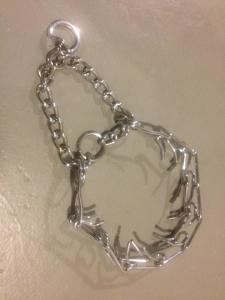
This is a copy of a recent article that I wrote forThe Pet Professional Guild: “Actions Speak Louder Than Words!” (pages 38 and 39) You can read the full magazine here: BARKS from the Guild Magazine Summer2014
Running Jambo’s Facebook page http://www.facebook.com/StaffyChampion has brought me into contact with a lot of people and pages that are passionate about the “Bully” breeds and want to see an end to Breed Specific Legislation. All these people and pages have one thing in common: They believe that the “Bullies” are unfairly discriminated against not only by legislation but also by the public in general.
It does, however, seem quite contradictory to me that, although all these individuals and pages look to convince the general public that the “Bullies” are not to be feared, that they aren’t inherently dangerous and that they are in fact just like other dogs (many would say better), they also believe that they need to be trained with a “stronger” hand. I’ve lost count of the number of times I see these very people (and sadly I even include rescue shelters) talk about these dogs needing a certain kind of owner, one who will be able to be an effective “pack leader” and not let their dog “take charge”!
I find it very difficult to understand how someone can say these dogs are no different to other dogs but also say that they need to be trained differently. They seem to believe that although positive reinforcement training may well work for some breeds it isn’t going to work with the “Bullies”! One post will show a picture of a “Bully” giving kisses and the next will show a picture of one wearing a prong collar. One post will be a story about an amazing “pit bull” therapy dog and the next will be advising their fans to make sure they “show their dog who is boss”!
I was absolutely stunned when an article which I had posted, explaining why prong and e-collars should not be used, actually received comments from people who said they were “sad” and “disappointed” to read this. They believed that thousands of dogs’ lives had been saved by rescue shelters using these tools to change the aggressive behaviour of dogs in their care and that, without the use of prong and shock-collars, these same dogs would not have survived. They were “disappointed” and “angry” that I was saying these collars had no place in training! These are very strong words and very strong opinions. Unfortunately, despite the fact that I think Jambo’s page shows just what can be accomplished without the use of these punitive tools, many of these individuals could not or would not be convinced. What amazed me the most was that they weren’t even willing to listen to the reasons why these tools shouldn’t be used! One individual even commenting that she couldn’t understand how I could say that prong collars or e-collars were a “punishment”! Despite explaining that the reason these “training tools” work is because the dog stops doing what he is doing, for example pulling on the leash or lunging, in order to avoid the prong collar being jabbed into his neck or a shock being received and that these “training” tools might well stop a behaviour but at what price to the dog’s physical and mental well-being, many of these individuals were so upset by what I was saying that they decided to “unfollow” Jambo’s page! I was absolutely flabbergasted to see that they would rather continue to treat their dogs in this way than even listen to an argument for training without force!
The “pack leader” mentality is, unfortunately, so ingrained in some people’s minds that they cannot even consider the possibility that it could be wrong! How do we get through to these people when there are still shows on the television with thousands, if not millions, of fans that regularly feature dogs being alpha-rolled, choked, shocked, kicked, prodded, poked, sprayed…?
How do we show these people that in order to successfully advocate for the “Bullies” and against breed discriminatory legislation they really do need to stop saying that you have to be a certain sort of person to “own” one of these dogs?… They need to stop propagating the myth that these dogs can only be “trained” using force! They need to stop saying that you need to be a “pack leader”. They need to stop “abusing” the very dogs that they are advocating for! How can they expect to convince not only the general public but also legislator’s that the “Bullies” shouldn’t be treated differently to other dogs if they themselves continue to say that they need a different method of training?… I don’t doubt that these people want the absolute best for their dogs but they need to realise that what they are doing to them on a daily basis is not only detrimental to their pet’s well-being, it is also propagating the myth that they are indeed different to other dogs! Their treatment of these dogs actually facilitates legislation against them! Not only that, but these punitive “training” methods and tools could also turn out to be the very reason their dog “bites back”!
So how do we convince the general public and the “powers that be” that the Bullies shouldn’t be discriminated against? How can you we convince people that they don’t need to use force to train their best friend? How can we be “the best ambassadors” possible?

I believe the only way we are going to do it is through actions! We need to show everyone just what our dogs are capable of when they are trained with rewards and not force. We can write as many articles as we want (and yes, there will be people who listen) but as the saying goes “the proof is in the pudding”. Let our actions and those of our dogs be the “pudding”! There are disc dogs, agility dogs, fly ball dogs, obedience dogs, trick dogs, service dogs, therapy dogs, police dogs, search and rescue dogs, dock dogs… who all happen to be “Bullies” and who have been taught using positive reinforcement! There are also lots of amazing family pets freely offering their kisses, cuddles and good behaviour who have all been trained without force! My beautiful boy, Jambo, is the First Staffordshire Bull Terrier To Be a Trick Dog Champion! (click the link to watch his Trick Dog Champion video). He achieved this title at just sixteen months old and guess what? I didn’t need to use a prong collar or give him any electric shocks! I managed to teach him all the behaviours using tiny pieces of food, a tug toy, a boomer ball and lots of love, patience and consistency!
The more people see and hear about these dogs, who I believe are a testament to Force-free Training, then the more people will be convinced that what they themselves are saying is true – “The Bully breeds aren’t any different to other dogs! They are not to be feared! They aren’t inherently dangerous!” They are, in fact, just like other dogs and guess what?… They can be trained in the same way – without fear, force or intimidation!
So, how do I believe you can be the “best ambassador possible” for the Bullies? Show people that they aren’t any different to other dogs in the way that you train them! Show everyone that there is absolutely no need to use punishment when you can use rewards! Celebrate the achievements of all those dogs that have been trained using rewards! Share training articles and videos that show people how they can effectively train their dog without being a pack- leader! Train your own dog without force! Show your friends and neighbours what an amazing dog he is! Let your actions and your dog’s actions speak for themselves! Maybe we need to stop telling people what they shouldn’t do and show them what we can do!
The “proof is in the pudding” after all!

You can view Jambo’s Trick Dog Champion video here: Jambo is the first Staffordshire Bull Terrier to be a Trick Dog Champion!
























